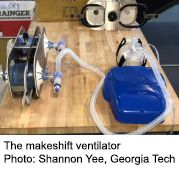- Navigating Your Midlife Crisis: Embracing New Possibilities
- City Raccoons Showing Signs of Domestication
- Mapping the Exposome: Science Broadens Focus to Environmental Disease Triggers
- One Week Less on Social Media Linked to Better Mental Health
- Your Brain Changes in Stages as You Age, Study Finds
- Some Suicide Victims Show No Typical Warning Signs, Study Finds
- ByHeart Formula Faces Lawsuits After Babies Sickened With Botulism
- Switch to Vegan Diet Could Cut Your Greenhouse Gas Emissions in Half
- Regular Bedtime Does Wonders for Blood Pressure
- Dining Alone Could Mean Worse Nutrition for Seniors
Cheap, Effective Ventilator Made From Ambulance ‘Resuscitation Bags’

With a sudden need for more ventilators due to the coronavirus pandemic, researchers have been busy trying to come up with alternatives to a standard ventilator.
Engineers from Georgia Tech and Emory University in Atlanta think they may have developed such a device. They’ve created a simple, low-cost ventilator that builds on the widely used resuscitation bags found in ambulances and emergency departments everywhere.
“The COVID-19 infection has an alarmingly high rate of respiratory distress associated with it, especially in certain vulnerable populations. The need for critical care beds, which are beds with ventilators, is acute, and health systems are not scaled up for the number of patients that will need mechanical ventilation support in this country and globally,” explained Susan Margulies, chair of biomedical engineering at Georgia Tech and Emory University.
Margulies said her team thought “the fastest way to have an impact would be to look at devices already used to support ventilation.”
The engineers focused on resuscitation bags, which are already used to manually push air into the lungs by squeezing the bag. The challenge was to transform it into a mechanical device, and to make it with as few parts as possible.
What they came up with is a device that uses two resuscitation bags, inexpensive metal, plastic gears and a simple power source. The device can be powered using a wall outlet, or a 12-volt vehicle battery.
Because it uses two bags, the emergency ventilator can be used on two patients. However, air flow for each person is completely separate.
The device can be shipped almost flat and then reassembled when needed. If necessary, device kits could be assembled using hand tools, the researchers explained.
The system is designed to be used on a temporary basis until a standard ventilator becomes available. But Margulies said that the system could be used for longer periods of time.
She said she doesn’t yet know what the cost would be, but thinks it would probably be hundreds of dollars, rather than the thousands that traditional ventilators cost.
Margulies said the amount and rate of air going into the lungs can be adjusted, and it can be varied from patient to patient.
So what’s missing from this inexpensive ventilator?
Dr. John Osborne is director of cardiology at State of the Heart Cardiology in Dallas, and wasn’t part of the study team. He said this resuscitation bag device doesn’t have the electronics that monitor air pressure and sound alarms.
“This is not a full-blown ventilator. It doesn’t have monitors, pressure sensors and alarms. I think this could be used for short, emergent periods of time. I don’t think people would use this for weeks,” he said.
But, Osborne said, the lack of electronics and monitors is also what makes this solution interesting.
“I love the simplicity of it. They’re starting with a sound process we already use — the ‘ambu bag’ — which is a proven principle and then add some mechanics to it. And, certainly where the choice is this device and nothing, this is a great option,” he said.
And Osborne noted that this wasn’t the only device in development.
“This current crisis will cause us to think outside the box and come up with new solutions. We may end up with valuable options going forward,” he said.
Once the coronavirus pandemic has passed, Margulies said this device could also be lifesaving in developing countries without access to traditional ventilators. The research team is now looking for a manufacturing partner.
Here’s Georgia Tech’s Shannon Yee explaining how the new ventilator was designed:
More information
Learn more about ventilators from the U.S. National Heart, Lung, and Blood Institute.
Source: HealthDay
Copyright © 2025 HealthDay. All rights reserved.










